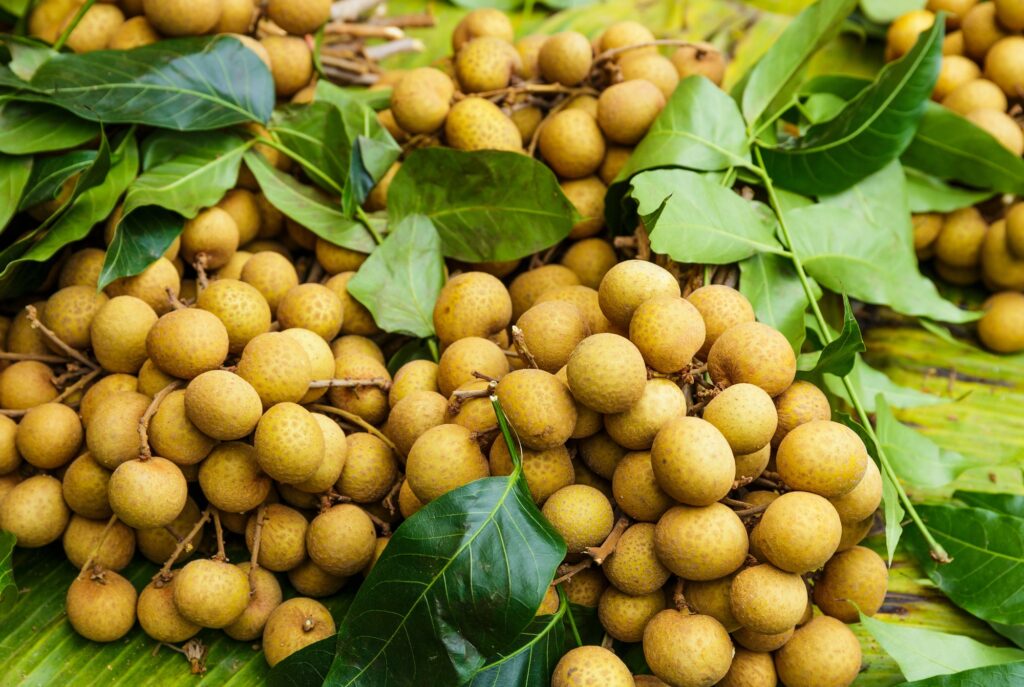16 Interesting Facts About Longan

Introduction
The longan fruit may not be as well-known as other tropical fruits like mangoes or pineapples, but it is quickly gaining popularity worldwide. Sometimes called “dragon’s eye” due to its appearance, longan is a unique fruit with a sweet, musky flavor and a range of potential health benefits.
Native to Southern Asia, longan has been used in traditional medicine and cuisine for centuries but is still considered an exotic delicacy in many parts of the world. If you haven’t tried fresh Longan before, you’re missing out! Read on to learn 16 fascinating facts about this intriguing fruit.

16 Facts About Longan
- Sweet and Succulent – The longan fruit is known for its deliciously sweet and juicy flesh. It has a similar taste profile to lychee, with a mildly floral and tropical flavor. The texture is like a grape, but slightly firmer and with a thin, translucent skin.
- Small in Size – Longans are about the size of a ping pong ball, with a thin, brittle, and light brown outer shell. Inside, it encases a translucent, juicy pulp with a single black seed.
- Easy to Peel – The full-ripened, freshly harvested longan has a bark-like shell that is thin and firm, making the fruit easy to peel by squeezing the pulp out as if one is cracking a sunflower seed.
- Dragon’s Eye – Longan’s name in Chinese translates to “dragon’s eye”1. This refers to the fruit’s resemblance to an eyeball when it is shelled, with the black seed as the pupil and the white flesh as the eyeball.
- Tropical Tree – Longan grows on evergreen trees that can reach up to 100 feet tall. The trees thrive in tropical areas with dry autumns and frost-free winters.
- Southeast Asian Origins – Longan is native to Southeast Asia. The majority of globally consumed longan originates from Vietnam, Thailand, and China where it has been cultivated for centuries.
- Rich in Nutrients – Fresh longan is high in vitamin C, potassium, phosphorus, and B vitamins. It contains antioxidants like flavonoids and polyphenols that can help boost health.
- Versatile Ingredient – Longan can be eaten fresh or used dried in various desserts, drinks, and savory dishes. It is often poached in syrup or added to smoothies, sorbets, and fruit salads.
- Traditional Medicine – In Chinese medicine, longan seeds and fruits are used in tonics to reduce stress, improve sleep, and nourish the blood. Longan tea is also popular.
- Symbol of Love – Giving longans is a traditional gesture of affection in Chinese culture. Longan symbolizes romance and is given as a gift to express love.
- Late Summer Harvest – The longan harvest takes place in the late summer, usually from July to September. Fruits are picked when they are fully ripe and ready to eat.
- Susceptible to Disease – Longan crops can be affected by fungal diseases like anthracnose and witch’s broom disease. Proper farming practices help prevent and control outbreaks.
- Lunar New Year Tradition – In Chinese culture, longan symbolizes good luck and prosperity. It is traditionally consumed during Lunar New Year festivities.
- New World Cultivation – Longan was introduced to Australia in the mid-1800s and to Hawaii and Florida in the early 1900s. It is now grown in suitable climates globally2.
- Closely Related to Lychee – Longan and lychee belong to the same plant family. Longan is less aromatic than lychee but has a sweeter, more musky flavor.
- Iron for Anemia – Longan contains iron that helps prevent anemia by improving red blood cell production and circulation.
Conclusion
In conclusion, longan is a fascinating and delicious fruit with a rich history and numerous health benefits. Whether eaten fresh or used in various culinary creations, longan never fails to delight taste buds and provide a source of nutrients. From boosting the immune system to promoting healthy digestion, longan offers a range of advantages that make it a fantastic addition to any diet. Its juicy, sweet flavor and unique texture make it a favorite among many fruit enthusiasts. So next time you come across this exotic fruit, don’t hesitate to give it a try and experience the wonders of Longan for yourself!

Frequently Asked Questions
What is longan?
Longan is a tropical fruit native to Southeast Asia. It belongs to the soapberry family and is closely related to other fruits like lychee and rambutan.
How does longan taste?
Longan has a sweet and floral flavor with hints of honey and musk. Its texture is similar to that of a grape, but slightly firmer and with a thin, translucent skin.
What are the health benefits of longan?
Longan is rich in vitamins, minerals, and antioxidants. It is known to boost the immune system, promote healthy skin, improve digestion, and provide a natural energy boost.
Can I eat longan if I have allergies?
If you have a known allergy to related fruits like lychee or rambutan, use caution when trying longan for the first time. Introduce it slowly and discontinue use if any allergy symptoms develop.





